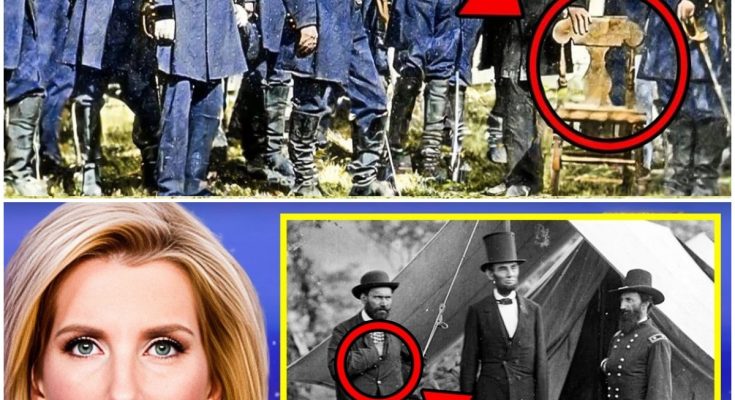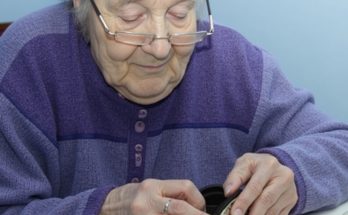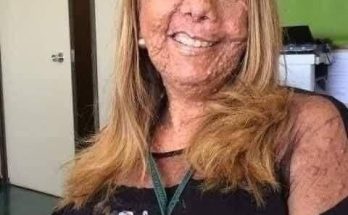What if a single photograph could change everything we know about American history? What if, buried in the dust of a forgotten attic, a century-old image emerged that defied every rule of time, technology, and memory?
This is the story of a photo—a relic so impossible, so haunting, that it shook historians, stunned archivists, and threatened to rewrite the legacy of Abraham Lincoln and the final days of the Civil War. But more than that, it’s the story of a silent figure who stood between Lincoln and Grant—a man erased from every record, yet entrusted with a secret too dangerous for history to remember.
It began with a trunk. Old leather straps, a brass latch, barely holding together after decades of heat and dust in the attic of Clare Donovan’s family home. Clare wasn’t looking for trouble or treasure; she was just cleaning, maybe hoping to find a few antiques worth salvaging.
Inside, the trunk was a time capsule: railroad bonds, lace gloves, faded letters, scattered buttons. But then, beneath the clutter, Clare’s hand brushed against something firmer—a leather photo album, its spine cracked, corners curling like dry leaves.
Most of the images inside were what you’d expect: stiff black-and-white portraits, blank faces, typical of the late nineteenth century. All except one.
Near the back, sealed in wax paper, was a single photograph. It felt different—thicker stock, sealed edges, and a faint scent Clare couldn’t place. Tobacco? Glue? Something old and strange. She resisted the urge to open it immediately, waiting until the room was clean, the dust gone, and her curiosity unbearable.
When she finally peeled back the wax sleeve, her breath caught. There, in haunting clarity, was Abraham Lincoln.
Lincoln stood in a black frock coat, his iconic top hat tilted in the sunlight at the extreme right of the frame. Beside him, an empty wooden chair. Around him, high-ranking Union officers—General Ulysses S. Grant, General George Meade—mid-conversation, sabers drawn.
But this was not an ordinary photograph.
It was in full color. Not hand-tinted, not painted after the fact. Deep blue Union uniforms, dusty brown boots, woodgrain on the chair, subtle light catching the creases of Lincoln’s suit. It looked like a modern photograph masquerading as a nineteenth-century print.
But color photography was impossible in 1865.
Clare knew she had something extraordinary. She took the photo to Professor George Kramer, a Civil War photography historian. When Kramer saw it, he didn’t speak—he just leaned in, hands trembling.
“You need to tell me exactly where you found this,” he said.
Clare explained everything—the attic, the trunk, the wax paper. Kramer didn’t blink. He pointed to the paper stock. “That is Albamman silver print. From the eighteen-sixties. There is no way it should hold color.”
“Is it fake?” Clare asked.
Kramer shook his head, pale. “No. That’s the scary part. It’s not fake.”
Kramer arranged for experts at the New York Historical Society to analyze the photo. Under high-resolution equipment, a forensic imaging specialist and a paper conservator worked side by side.
The lab results were staggering. The pigments weren’t applied after printing—they were embedded in the photo itself. The process was similar to early Kodachrome, but this photo predated it by fifty years. The scanner confirmed: color dyes, organic pigments, and photochemistry all dated to the eighteen-sixties.
It violated the rules of photography—and history itself.
But while the experts obsessed over the technology, Clare’s attention was elsewhere. In the middle of the frame, between Lincoln and Grant, stood a man no one could identify.
He wasn’t like the others. The officers stood stiffly, stripes and ceremonial sabers gleaming, but this figure was understated—no rank, no name matching any known Civil War portraits. He wore a uniform, but it lacked insignia. His expression was focused, steady, as if he weren’t just part of the photo, but part of something else entirely.
Then it hit her. Clare had seen this face before—not in a textbook, but in a much later family photograph. She pulled up a scan on her phone: a 1912 image of a man outside a barn, hand on a dog’s head. He was older, heavier, but the jawline, ears, and slope of the eyebrows—it was him. The same man. Standing beside Abraham Lincoln nearly fifty years earlier.
“That should be my great-great-grandfather,” Clare whispered.
Kramer looked up sharply. “What?”
Clare insisted. Kramer compared the images, brow furrowed. “He doesn’t show in any Civil War records. Could be a volunteer, maybe a civilian.”
Clare shook her head. “No. William Donovan. My grandfather’s stories said his grandfather served in the Civil War but disappeared before it ended. Listed as missing in action.”
She searched Civil War service records. Minutes later: Donovan, William—FOUND. Rank: Medic. Regiment: 104th New York Infantry. Status: Missing in Action. Last Seen: April 6th, 1865.
One entry. No explanation. Kramer’s gaze lingered. “April 6? Just three days before Lee’s surrender.”
Clare nodded. “So if he disappeared on April 6th… how does he appear in a photo from April 9th? With Lincoln? At Appomattox?”
Kramer was already digging through his laptop. “There are no known photographs of Lincoln at Appomattox. Only engravings, sketches, and letters. If this is real, it’s the first image to capture it.”
Clare felt both proud and terrified. Could it prove her great-great-grandfather was more than a battlefield medic? Or just in the wrong place at the wrong time?
But the silence around Donovan felt curated, constructed. Not historical forgetfulness, but deliberate erasure.
She remembered an old letter her grandfather used to show her—yellowed, barely readable, written by William Donovan decades after the war: “If ever you find the photograph with the chair, burn it. It was never meant to be kept.”
This was no ordinary relic. It was hazardous. The air felt denser, loaded with the knowledge that history is never as stable as it seems.
Why was Donovan, officially missing, standing beside Lincoln after his disappearance?
Back at the New York Historical Society, Kramer dug into War Department archives. Late one evening, he called Clare. “I found something. You need to get down here now.”
Kramer pulled up a rarely accessed field record from April 1865. One line in a broader memo: “WD: Moved to Shadow Post per Al’s request. Not to be logged. No weapons drawn unless required.”
“WD?” Clare asked.
“War Department,” Kramer replied. “And ‘Al’… that’s most likely Lincoln. A nickname used in private communications.”
What began as a misfiled photograph was now attached to an official document suggesting Lincoln may have created an informal shadow unit—operating outside the public military hierarchy.
One that included men like William Donovan.
Further records revealed a field journal: “Temporary escorts assigned for sensitive movement between command zones—selected outside normal rank.” No badges, no papers, only quiet orders to stand watch, report silently, and protect key figures—including the president.
“Lincoln built his own network,” Kramer said. “Rumors have always existed, but I’ve never seen anything concrete.”
The most damning proof came not in words, but in fabric.
Elsa, the forensic imaging specialist, zoomed in on Donovan’s coat. “There’s something here,” she said, focusing on the collar.
A tiny, meticulously stitched patch hidden under the lapel, faint but identifiable: P.E.C.
“Presidential Escort Committee,” Kramer said. “Not official, but mentioned in coded communications and personal diaries.”
Lincoln, near the end of his presidency, didn’t fully trust his cabinet. He wanted eyes and ears in the field—people reporting directly to him.
Donovan’s badge was irrefutable evidence: he hadn’t disappeared, but had been reassigned, removed from his regiment, and placed at Lincoln’s side.
But why such secrecy? Why undocumented members? Why allow Donovan prominence in the photo, then erase him completely?
Kramer rubbed his eyes. “Lincoln knew the war was ending, but peace was fragile. He needed trustworthy people at the last moment. Not generals. Not politicians. Ghosts.”
Ghosts like William Donovan.
The empty wooden chair in the photograph took on new meaning—a marker, a space kept open for danger, decisions, or for someone like Donovan to step



